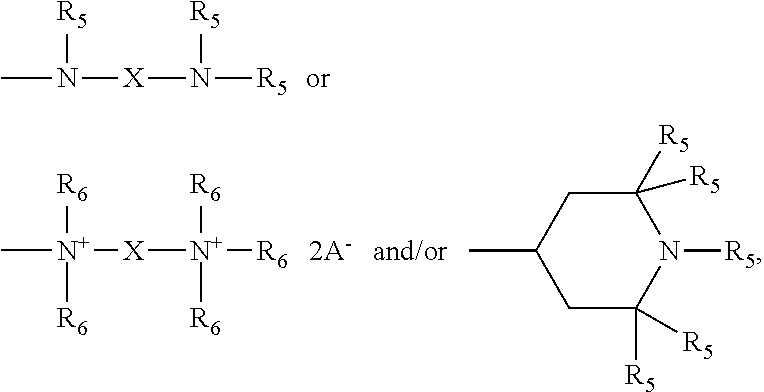Fabric care conditioning composition in the form of an article
a technology of conditioning composition and fabric, applied in the field of fabric care conditioning composition, can solve the problems of affecting the associated shipping and storage costs, affecting the quality of finished products, and affecting the packaging, storage, transportation and/or convenience of bulk liquid product forms, etc., to achieve excellent conditioning benefits, convenient and fast dose and dissolution, desirable softness and flexibility
- Summary
- Abstract
- Description
- Claims
- Application Information
AI Technical Summary
Benefits of technology
Problems solved by technology
Method used
Image
Examples
example 1
Polyvinyl Alcohol and Glycerin Solution
[0168]The following polymer solution compositions were prepared for use during the preparation of the dissolvable porous solids of the present invention:
[0169]
Ex. 1AEx. 1BComponentWt %Wt %Polyvinyl alcohola22.0014.00Glycerin7.3315.50Distilled water70.6770.50Total100.00100.00a87-89% hydrolyzed, MW 85,000 to 124,000 available from Sigma Aldrich (Catalog Number 363081)
[0170]Into an appropriately sized and cleaned vessel, the distilled water and glycerin is added with stifling at 100-300 rpm. The polyvinyl alcohol is weighed into a suitable container and slowly added to the main mixture in small increments using a spatula while continuing to stir while avoiding the formation of visible lumps. The mixing speed is adjusted to minimize foam formation. The mixture is slowly heated to 82° C. while continuing to stir, and is heated at 82° C. for at least 30 min. The mixing vessel is covered to minimize evaporation.
example 2
Dissolvable Porous Solid Fabric Conditioners Prepared from a Retail Liquid Fabric Softening Product (Downy Ultra April Fresh)
[0171]The following dissolving porous solid is prepared in accordance to the present invention:
[0172]
ComponentWt %Polyvinyl alcohol premix from Example 1A51.35Retail Downy Ultra April Fresh44.40Tween-60a4.25Total100.0aAvailable from Sigma, catalog number P1629.
[0173]The above composition is prepared by mixing via a SpeedMixer™ DAC 400 FV available from FlackTek, Inc., Landrum, S.C. 250 grams of the above components in the given amounts are added into a Max 300 SpeedMixer™ plastic jar with all components being at room temperature. The mixture is thoroughly mixed within the SpeedMixer™ which is run at a rage of approximately 2,750 rpm for a time period of at least 30 seconds.
[0174]This mixture is transferred into a 5 quart stainless steel bowl of a KitchenAid® Mixer Model K5SS (available from Hobart Corporation, Troy, Ohio) and is preheated to 80° C. using a con...
example 3
Dissolvable Porous Solid Fabric Conditioners Prepared from a Retail Liquid Fabric Softening Product (Downy Simple Pleasures Amethyst Mist)
[0176]The following dissolving porous solid is prepared in accordance to the present invention:
[0177]
ComponentWt %Polyvinyl alcohol premix from Example 1A49.18Retail Downy Simple Pleasures Amethyst Mist45.92Tween-60a4.90Total100.0aAvailable from Sigma, catalog number P1629.
[0178]The above composition is prepared by mixing via a SpeedMixer™ DAC 400 FV available from FlackTek, Inc., Landrum, S.C. 250 grams of the above components in the given amounts are added into a Max 300 SpeedMixer™ plastic jar with all components being at room temperature. The mixture is thoroughly mixed within the SpeedMixer™ which is run at a rage of approximately 2,750 rpm for a time period of at least 30 seconds.
[0179]This mixture is transferred into a 5 quart stainless steel bowl of a KitchenAid® Mixer Model K5SS (available from Hobart Corporation, Troy, Ohio) and is prehe...
PUM
 Login to View More
Login to View More Abstract
Description
Claims
Application Information
 Login to View More
Login to View More - R&D
- Intellectual Property
- Life Sciences
- Materials
- Tech Scout
- Unparalleled Data Quality
- Higher Quality Content
- 60% Fewer Hallucinations
Browse by: Latest US Patents, China's latest patents, Technical Efficacy Thesaurus, Application Domain, Technology Topic, Popular Technical Reports.
© 2025 PatSnap. All rights reserved.Legal|Privacy policy|Modern Slavery Act Transparency Statement|Sitemap|About US| Contact US: help@patsnap.com


